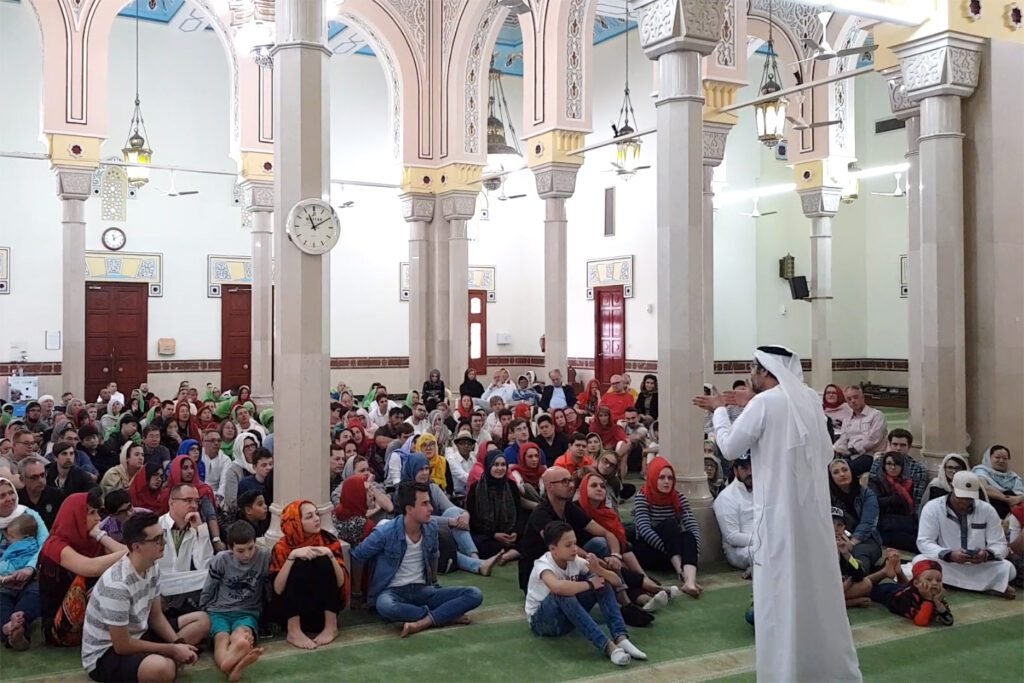One of the best places to see this is the Jumeirah Mosque—a place of worship, culture, and learning that welcomes everyone, not just Muslims.
Located in the Jumeirah district, this beautiful mosque stands out with its white stone walls, traditional Fatimid architecture, and two elegant minarets. It is not only a place where Muslims gather for prayer, but it is also one of the few mosques in the United Arab Emirates that is open to non-Muslim visitors. Because of this, it plays an important role in building understanding between people of different cultures and religions.
A Glimpse Into Islamic ArchitectureWhat Makes Sheikh Khalifa Mosque in Al Ain So Breathtaking?
The Jumeirah Mosque is often called one of the most photographed mosques in Dubai—and for good reason. Built entirely in white stone, it shines under the sunlight during the day and looks magical when lit up at night. The design follows the Fatimid style, which comes from North Africa and Egypt and is known for its symmetry, clean lines, and detailed carvings.

Inside, the mosque has a large prayer hall with beautiful Arabic calligraphy and a dome decorated with traditional patterns. The red and gold carpet, high ceilings, and chandelier lights give it a peaceful and majestic feel. Every part of the building has meaning—from the direction the prayer space faces (toward Mecca), to the verses from the Quran written on the walls.
More Than Just a Mosque

What makes Jumeirah Mosque truly special is its openness to visitors of all backgrounds. Six days a week, the mosque holds guided tours run by the Sheikh Mohammed Centre for Cultural Understanding (SMCCU). Their motto is “Open Doors, Open Minds,” and it perfectly describes what they do.
During the tour, guests can learn about Islam, local culture, and the role of mosques in daily life. The tour also includes a Q&A session where visitors can ask anything they want—whether it’s about prayer, fasting, family life, or traditions in the UAE. No topic is off limits, and the goal is to create honest and respectful conversations.
One unique part of the experience is the traditional Emirati snacks served at the start of the tour. Guests are offered Arabic coffee, dates, and other local treats, which help create a welcoming and friendly atmosphere. It’s not just a tour—it’s a chance to connect and learn.
A Short History

The Jumeirah Mosque was built in 1979 and was one of the first large mosques in Dubai that aimed to be open to the public. Since then, it has become an important symbol of the city’s efforts to promote tolerance and cultural exchange.
The mosque’s design was inspired by Al-Azhar Mosque in Cairo, Egypt. Its construction was carefully planned to reflect both Islamic tradition and Dubai’s unique identity. Over the years, it has become a key stop for visitors who want to go beyond shopping malls and beaches and truly understand the spirit of the city.
Respect and Dress Code
Visitors are welcome to take pictures, explore the mosque, and ask questions, but there are also guidelines to follow. Modest dress is required—women are asked to cover their heads, arms, and legs, while men should wear long pants and shirts with sleeves. If visitors don’t have the right clothes, the mosque provides traditional garments at the entrance.
Shoes must be removed before entering the prayer hall, just like in all mosques. It’s also important to stay quiet and respectful while inside, especially during prayer times.
These small steps help visitors show respect for the religious nature of the space and allow everyone to enjoy a peaceful and meaningful visit.
A Message of Tolerance
Dubai is home to people from over 200 nationalities. The Jumeirah Mosque reflects the city’s efforts to live in peace despite cultural differences. By opening its doors to non-Muslims, it invites people to look past stereotypes and learn from each other.
For many tourists, visiting the mosque becomes one of the most memorable parts of their trip. It’s not just about taking pictures—it’s about gaining a better understanding of Islam and the values that guide life in the UAE.
Planning Your Visit
Tours are usually held from Saturday to Thursday, starting at 10:00 a.m. It’s a good idea to arrive 15–30 minutes early to register and enjoy the traditional refreshments. The entire experience lasts about 75–90 minutes.
There’s no need to book in advance, and the cost is very low—usually around 35 AED (a little under $10 USD). Children under 12 can join for free.
Photography is allowed throughout the visit, so you can bring your camera or phone. Many visitors say the photos they take at Jumeirah Mosque are among their favorites from Dubai.
Why You Should Visit
In a city filled with luxurious attractions, Jumeirah Mosque offers something different: a real connection to the culture and people of the UAE. It’s a chance to step into a sacred space, ask honest questions, and leave with a better understanding of a religion followed by over a billion people worldwide.
You don’t have to be religious to appreciate its beauty or learn from the experience. All you need is curiosity and respect.
Whether you’re visiting Dubai for the first time or have lived there for years without exploring its deeper roots, the Jumeirah Mosque is a peaceful, meaningful stop that will stay with you long after you leave.
Also read: What Makes Sheikh Khalifa Mosque in Al Ain So Breathtaking?













